

BEYOND THE NOW
SPOTTING AN ICON AT ANY AGE


















Steyn City is more than a place to live— it’s a lifestyle curated for those who appreciate the extraordinary YOUR SANCTUARY


















Build your dream home on one of our newly launched stands, explore luxury apartment living at City Centre, or enjoy inspired living in the recently introduced Senior Village. For those seeking flexibility and style, our modern rental apartments offer the perfect fit.
There’s never been a better time to invest in this exceptional address.
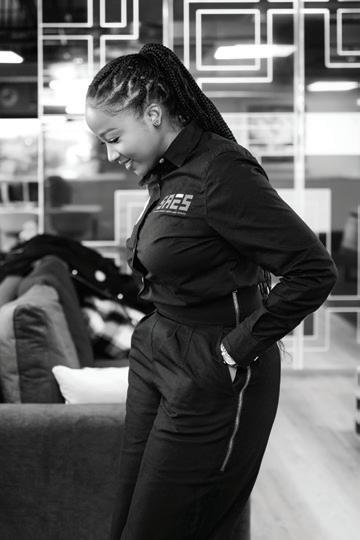
How
An exclusive extract from Cartier by Helen Molesworth highlights the history of an iconic tiara



























Spier








We’ve recently hit the 10 000-follower mark on Instagram, and we’re incredibly grateful to our amazing readers, clients, and friends of the brand.
I couldn’t be more excited about YourLuxury Africa’s digital future. This milestone happens to coincide with the creation of this beautiful issue – an exploration of age and all things timeless.
Whether you’re a young pioneer like the under-25’s Amonge Elethu Sinxoto speaks to on page 34, or one of the seasoned creatives who inspire Ryan Enslin (page 30), it’s clear that while numbers matter, they’re not the only measure for a life well-lived. This issue also got me thinking about how luxury brands like Cartier (page 22; page 26) and Spier (page 46) have stood the test of time, while others fade with the years. As someone in my mid-40s, I find myself reflecting – I have equally as many days behind me as I do ahead of me… I hope.
ON THE COVER

Here’s what I’ve learnt about time and ageing…
1. Age is not a number; it’s a state of mind – Getting older is inevitable, but feeling old is an option. You get to choose how you see yourself.
2. Time is relative; don’t be tethered to it – We invented time to help us organise life. It’s a useful mental construct, but it’s up to you to use it to your advantage. Don’t let time use you.
3. How you look matters. Don’t waste it – Don’t be fooled, there’s a reason why good-looking people get ahead. You don’t have to be Beyoncé or Brad Pitt to feel good about yourself. Work with what you’ve got.
4. You’re going to get old eventually. Be nice – The internet is filled with young people who have opinions about what people over 50 should look like. And we also have 50-yearolds trying to look 20. Let’s be nice about each other; being nasty about people’s looks is just bad karma.
5. The young and the restless –If you’re under 30 and reading this, it’s your responsibility to disappoint others in defence of yourself. There’s nothing worse than selfbetrayal. Let them down, so you don’t let yourself down.


Bvlgari
6. They didn’t lie, life really does begin at 40 – I hate it when clichés turn out to be true, but turning 40 changed everything. My knees may creak when I dance, my eyesight may be bidding me adieu, but I’ve never loved myself or my life more.
7. Dress for the occasion. Every day is an occasion – If you want wear a tutu on a Tuesday, do it. If you want to don all your accessories at once, go ahead. Adorn a skirt if you’re a man. Life is too short to hide who you are.
8. Rest. It’s a requirement, not a niceto-have – We live in crazy financial times where productivity is more valued than rest. Believe me when I say: rest is not something you should feel guilty about; it’s a prerequisite to a healthy life.
9. If you feel the need to dance, ignore the cameras (and your pride). Just dance – Our ancestors sang and danced because it’s good for our nervous system. It’s a joyful way to express yourself. Just dance, you’ll be glad you did it.
10. You’re going to die one day, so be yourself anyway – Life is relentless. You won’t be able to fake it forever, especially if you do make it, so be authentically yourself while you still have the chance. That’s why there’s only one you.

MY TOP PICKS
Clarins has just celebrated a decade in the business with the release of the Lip Comfort Oil in a limited-edition colour, Iconic Red No. 54.

gorgeous coloured gemstones, like amethyst and peridot.

La Prairie’s Platinum Rare Haute-Rejuvenation Elixir is boosted with the power of Platinum MultiPeptide technology and La Prairie’s Exclusive Cellular Complex. It addresses every dimension of ageing, from loss of firmness and elasticity to deep-set lines, uneven tone, and dullness.


The new Black Bay 58 Carbon 25 Master Chronometer, with carbon fibre, now comes in burgundy. Named after the year the first TUDOR diver’s watch – reference 7924, famously known as the “Big Crown” – was introduced with a water resistance of up to 200 metres.


Photographer: Judd van Rensburg
Photographer’s Assistant: Kaykay Ribane Model: ICE Models
Panthère de Cartier watch, POA; Clash de Cartier bracelet, R255 000; Clash de Cartier ring, R93 000; Panthère fauna and flora bandeau, R4 250; Handle bag, mini, Panthère C de Cartier, R67 000
’s Polychroma takes its name from the Greek roots ‘poly’ (meaning multitude) and ‘chromia’ (meaning colours), paying homage to Rome, the ‘Eternal City’. The Polychroma high jewellery collection showcases the brand’s

JOHANNESBURG • SHOPU28A/B, DIAMOND WALK. SANDTON CITY +27 11 883 1325
JOHANNESBURG
BVLGARI BOUTIQUE
SHOPU28A/B, DIAMOND WALK. SANDTON CITY +27 11 883 1325 CAPE TOWN • BHH BOUTIQUE • V&A WATERFRONT, CAPE TOWN. +27 21 418 1889
JOIN US ONLINE


ONLINE THIS MONTH…
Scheduled to open this month on the banks of Kenya’s Sand River, The Ritz-Carlton’s Masai Mara Safari Camp marks the iconic hotel group’s debut in the luxury safari sector. Elevated three metres above ground, the camp blends biophilic design – featuring filtered natural light and the soothing sounds of the river –with contemporary elegance.
We also profile local designer, Imran Mohamed – the visionary reshaping South Africa’s fashion scene through his label, Asa Sadan. Based in Cape Town and rooted in Indian and Cape Malay heritage, his latest collection, Fairyland, explores the lived experiences of the District Six community,
both during and after the forced removals of the apartheid era. Building on themes first explored in the Dissertation Studies collection and later deepened in Asa’s debut fashion film, In Loving Memory, Imran is carving out a space in global fashion where storytelling outweighs spectacle.
For more stories and to join the YLA Club, follow us online at YourLuxury.Africa
SUBSCRIBE TO OUR NEWSLETTER:
Every week we bring you a wrap of our top stories on our digital platforms. For the best in travel, fashion, wealth, art, and culture, subscribe now.
MEET OUR CONTRIBUTORS
HOW DO YOU FEEL ABOUT AGEING?

AMONGE
ELETHU SINXOTO
“My relationship with age has become more tender and conscious as I’ve gotten older. When you’re young, you don’t realise how quickly time moves; you just assume proximity and connection will always be available. I want to be present for all of it – the becoming, the unbecoming, the growing – because when you look back, the moments that felt small are the ones that stay with you.”
See: p34

INNOCENT NDLOVU
“There was a period in my life when the thought of growing older felt intimidating, and I didn’t know how to navigate it. These days, I welcome it with open arms. I’ve come to realise that while time moves forward, traditional crafts, ’90s music, and luxury remain timeless.”
See: p40

PHILA TYEKANA
“My relationship with ageing has been beautiful, marked by deep character development and spiritual alignment. What I appreciate most is how age has brought greater harmony between my body, spirit, and soul. I’ve become more selfaware and intentional in how I move through the world, and much of that clarity has come from finding God. There’s a peace and confidence that only He can provide, which is timeless and unshakable.”
See: p48

RYAN ENSLIN
“I’ve come to understand age not as a boundary, but as a deepening of depth and clarity. To me, excellence isn’t tethered to youth but rather forged by the gift of time. And what’s timeless is an enduring curiosity, and the fierce beauty of those still creating on their own terms.”
See: p30
EDITORIAL: EDITOR Lerato Tshabalala lerato@yourluxury.africa
EDITORIAL & BEAUTY EDITOR Ingrid Wood ingrid@yourluxury.africa CREATIVE DIRECTOR Kate Walters COPY EDITOR Tamlyn Cumings CONTRIBUTING EDITOR Leigh Herringer IMAGE EDITOR Coralie Elske DIGITAL EDITOR Jessica Levitt jessica@yourluxury.africa TRAFFIC CO-ORDINATOR Rachel Ndawo
ADVERTISING & MARKETING: ADVERTISING DIRECTOR Yvonne Sha +27 (82) 903 5641 I yvonne@yourluxury.africa ADVERTISING CO-ORDINATOR Yvette Mehl + 27 (21) 439 4907 I yvette@yourluxury.africa ACCOUNT MANAGER: NATIONAL Gina van de Wall I gina@yourluxury.africa SALES EXECUTIVE: Sumeshni Pillay I sumeshni@yourluxury.africa ADVERTISING SALES MANAGER: LONDON AND THE UK Louella Stocchi I louella@yourluxury.africa MANAGEMENT: MANAGING DIRECTOR Yvonne Sha DIRECTOR Jacquie Myburgh Chemaly
DISTRIBUTION & PRINT: DISTRIBUTION On the Dot, Media Support PRINTED BY CTP Printers, Cape Town for YourLuxury PO Box 1053, Sea Point 8060, Cape Town. All rights reserved. Whereas precautions have been taken to ensure the accuracy of information, neither the editor nor YourLuxury Africa can be held liable for any inaccuracies, injury or damages that may arise. The opinions expressed in the articles may not reflect those of the publisher. All prices correct at time of going to print.






TDividend The
WORDS BRIGHT KHUMALO
here’s a story that first surfaced in Panerai magazine, which is often spoken of reverently in horology circles. It’s said that South African businessman, Johann Rupert, noticed a wristwatch worn by another prominent South African entrepreneur, asked about it, and within weeks had snapped up troubled Panerai for just €1 million. But what he got in return was far more than a limited-edition diver’s timepiece – it was the crown jewel in what would become the world’s most formidable luxury watch empire.
Under Johann’s stewardship, Richemont has become the undisputed custodian of Swiss watchmaking heritage. While others chase trends, Richemont builds legacies. The group owns a glittering array of Maisons – no fewer than 11 luxury watch brands, including icons like Vacheron Constantin, A. Lange & Söhne, and the powerhouse that is Jaeger-LeCoultre.
Ah, Jaeger-LeCoultre – the watchmaker’s watchmaker. This Maison has been crafting mechanical marvels since 1833 and is responsible for over 1 200 calibres and countless patents. What makes Jaeger truly magical is not only its innovation, but its restraint. You won’t find TikTok influencers showing off their Reversos. Instead, you’ll find seasoned collectors, diplomats, and CEOs checking the time before their next high-stakes decision.
And then there’s IWC Schaffhausen. Renowned for its engineering-led aesthetic and robust designs, IWC was perhaps boldest when it became the official sponsor of the MercedesAMG Petronas Formula One team in 2013. A watch brand on the wrist of Lewis Hamilton, racing past the competition at 300km/h, was more than marketing – it was symbolic. Engineering excellence, precision, and dominance: all values both brands share.
But Richemont doesn’t just sell watches; it sells stories decades and centuries in the making. Each tick of a Vacheron, each chime of a minute repeater from A. Lange & Söhne, speaks of the impossible pursuit of perfection. And it’s this relentless dedication to detail that has built a cult-like following. In an era of microbrands and quartz fashion pieces, Richemont’s Maisons feel like temples of permanence.
Yet here’s the twist that only seasoned investors know. While the watches have become coveted collectables, Richemont’s shares have outperformed many of the pieces in its catalogue. The luxury business, when run with Johann’s rigour and obsession for heritage, prints profits as reliably as a Tourbillon keeps time.
Panerai now makes an estimated 70 000 watches per year, a staggering return on that wrist-inspired purchase. But that’s just a footnote in a story about vision. While LVMH commands the spotlight and Swatch dominates by scale, Richemont quietly holds the heart of Swiss watchmaking. Its Maisons are timehonoured institutions.
As the luxury world grapples with shifting tastes, younger buyers, and the digitisation of desire, Richemont’s steady hand (pun intended) continues to set the pace. ■
10039903 NBPW Connected Wealth Print - Your Luxury Africa (165x240)
Bright Khumalo is a Portfolio Manager and Analyst at Vestact Asset Management

FNB ART JOBURG –OPEN CITY EDITION
28 AUGUST – 11 SEPTEMBER | JOHANNESBURG, SOUTH AFRICA
Once again, Sandton’s financial district becomes Africa’s cultural nerve centre as FNB Art Joburg maps the continent’s creative and luxury evolution. The Open City Edition spans 16 days, with the BMW Art Generation showcase offering a fascinating glimpse into the continent’s emerging talent. Gallery tours reveal curatorial thinking, artist talks uncover creative processes, and VIP receptions facilitate the conversations shaping art-market trends. This annual gathering attracts Pan-African tastemakers who recognise that contemporary African art is one of the world’s most dynamic collecting categories. Don’t miss it. artjoburg.com
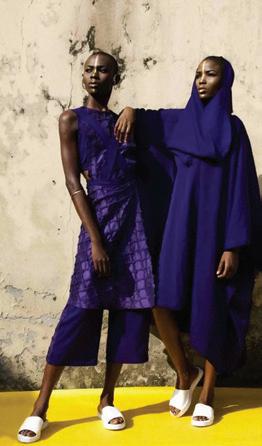
COPENHAGEN FASHION WEEK
4–8 AUGUST | COPENHAGEN, DENMARK
Copenhagen’s cobblestones have witnessed many cultural exchanges, but few as significant as IAMISIGO’s runway debut this month. The Ghanaian-Nigerian label arrives in Scandinavia for one of African fashion’s most prestigious international moments, bolstered by Naomi Campbell’s endorsement and a €50 000 Zalando Visionary Award. Creative Directors Bubu Ogisi and Darlyne Komukama understand that fashion shows are political acts, and their SS26 collection speaks to global audiences whilst honouring African craftsmanship traditions. Copenhagen Fashion Week’s sustainability focus aligns perfectly with their conscious luxury approach, fostering dialogue between Nordic minimalism and African maximalism. copenhagenfashionweek.com

BUSINESS PREMIUM JAZZ FESTIVAL
2 AUGUST | JOHANNESBURG, SOUTH AFRICA

Johannesburg’s most discerning music lovers have quietly cultivated something remarkable over the past decade. The Business Premium Jazz Festival at Carnival City’s Big Top Arena celebrates its 10th anniversary this Women’s Month with a line-up that reads like African music royalty: think Lira, Amanda Black, and Thandiswa Mazwai. What began as networking with a soundtrack has evolved into the city’s premier cultural salon, where black-tie conversations flow as smoothly as the tunes, and each artist brings a different chapter of contemporary African femininity to the stage. computicket.com
CULTURE DIARY

9 AUGUST | JOHANNESBURG, SOUTH AFRICA
When Grammy winners cross oceans for a single evening, you know something significant is unfolding. This Women’s Day Anthony Hamilton and Joe Thomas join South African singers Zonke, Sjava, and Vusi Nova to transform the DP World Wanderers Stadium into a temple of feminine celebration. The stadium, which usually echoes with cricket cheers, will become a vessel for soul music, where 40 000 voices unite to sing along to hits like Anthony’s Charlene and Zonke’s Viva the Legend webtickets.co.za
MAISON & OBJET – PARIS DESIGN WEEK EDITION
4–8 SEPTEMBER | PARIS, FRANCE
September traditionally signals the return of serious cultural conversations in Paris – and Maison & Objet delivers the year’s most important design discourse. Artistic Director Amélie Pichard has orchestrated a gathering where brands transform the industrial halls of the Nord Villepinte Exhibition Centre into a living museum of contemporary taste. Six sectors tell the story of how we live now: Cook & Share reflects our dining evolution, while Fragrance & Wellness speaks to our obsession with health and wellbeing. Twenty trend talks provide the intellectual framework, but the real education happens as you wander among objects that define tomorrow’s interiors. maison-objet.com



3 DAYS POWER RESERVE AUTOMATIC CALIBRE
CROWN PROTECTING DEVICE PATENTED IN 1956 500 M WATER RESISTANCE





















IN 2025, WATCHMAKERS ARE REVISITING ICONS TO REDEFINE HOW WE EXPERIENCE TIME. THESE PIECES PROVE INNOVATION DOESN’T RUSH
WORDS DEBBIE HATHWAY



TIME The shape of











1. Omega’s Aqua Terra brings a smile to small-watch fans with a 30mm case and 12 new references, including steel, gold, and two-tone models. Each features a vibrant dial, integrated bracelet, and brand-new movement engineered for scale. With Master Chronometer certification, the Aqua Terra 30mm represents precision and elegance in its most compact form yet. From R139 000, omegawatches.com
2. This year, Rolex refreshes its Oyster Perpetual line with soft matte pastel dials – lavender (28mm), beige (36mm), and pistachio (41mm). The 41mm model also gains a sleeker case and clasp. Cutting-edge calibres and certified Superlative Chronometers power all of them, combining Rolex precision with refined, contemporary colour. POA, rolex.com






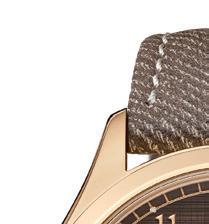












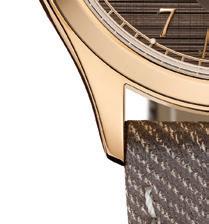
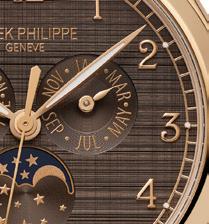



4. Hermès brings its whimsical “Le temps suspendu” complication to the geometric Cut collection. Designed in a 39mm rose gold case, the Manufacture Hermès H1912 movement disrupts the usual flow of time with flair. The counterclockwise rotation of the running indicator provides another fun element. A red dial one-shot version leads the lineup, inviting wearers to savour the moment, not measure it. POA, hermes.com, bhhboutique.co.za



3. Breitling’s Superocean Heritage gets a sharp, elegant update with slimmer profiles, enhanced symmetry, and technical upgrades. Spanning 36-44mm, the collection debuts the B31 in-house calibre and features flagship Caliber 01 chronographs. Clean dials, ceramic bezels, and distinguished bracelets complete a design evolution rooted in the 1957’s streamlined original. From R117 000, breitling.com
5. Patek Philippe’s 4946R-001 Annual Calendar introduces a non-gem-set rose gold model with a 38mm case and a chestnut dial inspired by Shantung silk. Paired with a denim-pattern leather strap, it blends casual texture with classic enhancement. The patented calendar complication requires adjustment just once a year – at the end of February. POA, patek.com































LONGINES SPIRIT
ZULU TIME 1925
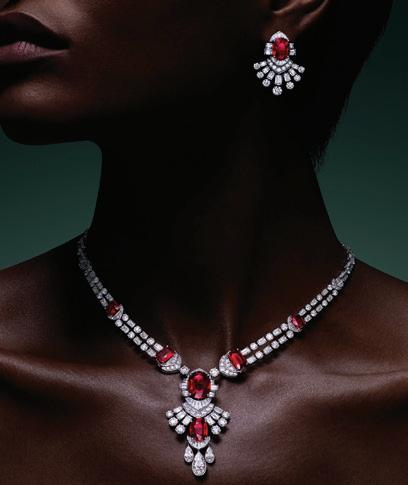
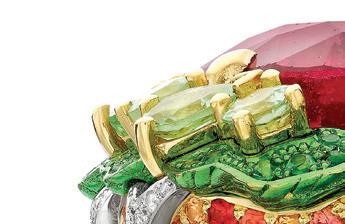

ICONIC


WHETHER IT’S BVLGARI’S CHROMATIC BEAUTIES OR GRAFF’S DIAMOND MASTERPIECES, THIS YEAR’S HIGH JEWELLERY COLLECTIONS CELEBRATE THE BOLD VISIONS OF THE WOMEN WHO DESIGNED THEM WORDS DEBBIE HATHWAY


Transcendent Beauty collection: oval Mozambique ruby earrings with multi-shape white diamonds, set in white gold, POA; 9.09ct oval Mozambique ruby necklace, with cushion-cut rubies and white diamonds, set in white gold and platinum, both POA; gra .com
2. Boodles’ A Family Journey –Around Africa in 10 Days collection: Africa Inside Africa Sunset tourmaline ring with one 20.39ct tourmaline as well as diamonds, tsavorites, and coloured sapphires. POA, boodles.com



HEIRLOOMS A


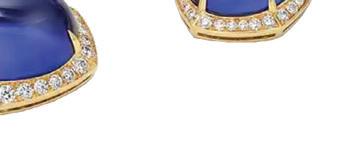
3. Chopard’s Red Carpet Collection: flower earrings in titanium with white opal cabochons, and pink and yellow sapphire and ruby pavé. POA, chopard.com, bhhboutique.co.za
4. Louis Vuitton’s Pure V collection: Pure V Three-Row 18kt white gold bracelet. POA, louisvuitton.com
5. Bvlgari’s Polychroma high jewellery collection: Tanzanite Falls necklace with five royal blue tanzanites, totalling 104.69ct. POA, bulgari.com; bhhboutique.co.za

cross the globe, the latest high jewellery collections not only reflect a deep respect for craftsmanship, materials, and storytelling, but also the visionary talent of the women behind them. Inspired by movement, memory, and a sense of place, personal stories are made into wearable works of art, brought to life by skilled artisans using time-honoured techniques to reveal the natural beauty of rare stones. These are jewels with both soul and substance – their materials are sourced responsibly. They o er a glimpse into the creative vision of the remarkable women who are redefining what it means to lead in the world’s most prestigious high jewellery houses.

























































































































































































































































Lamelle Correctives
Vita C Lipid Serum o ers a lipid-soluble form of Vitamin C. It’s one of the best radiance boosters and a powerful antioxidant – due to the ascorbic acid – while being gentle enough for sensitive and dry skin. R1 105, skinmiles.com
What sets Estée Lauder Advanced Night Repair apart is Tripeptide-32 (the peptide from 60 million variations) that optimises the skin’s natural rhythm of repair and renewal. That secret is patented until 2033 – it did, after all, take 40 years of night science research. R2 580 for 75ml, esteelauder.co.za




Sisley’s iconic Black Rose collection is the ultimate plumping radiance booster, and the Black Rose Eye Contour Fluid has earned its place in the eyecare hall of fame. It soothes, refreshes, and minimises pu ness, while the massage action from the ceramic applicator promotes circulation. R2 800, sisley-paris.com/en-ZA
LASTING Impressions



There are many reasons Nuxe Huile Prodigieuse has cult status: the dry oil can be used on your face, body, and hair to nourish and repair; it has an addictive scent; and it absorbs quickly without residue. From September, it will also be available in a roll-on for easy all-over application. R745 (R815 for the golden glow variant), orleanscosmetics.co.za







When Francois Nars created a monochromatic look on American model Carolyn Murphy with only one colour, NARS The Multiple became an overnight sensation. The cream-to-powder makeup stick can be used to highlight, sculpt, and add warmth to the face and body. The reformulated version launching in September has 11 new shades and an upgraded longer-lasting texture. R1 015, narscosmetics.co.za

THESE ICONIC BEAUTY PRODUCTS PROVE THAT TRUE PERFECTION STAYS FOREVER
COMPILED BY INGRID WOOD

YSL Touce Eclat, a light-reflecting concealer and highlighter, shook up the beauty industry when it launched in 1992. The illuminating click-pen with a brush applicator can be used on the entire face – your complexion’s secret weapon. R745, edgars.co.za




Initially created in 1930 by Elizabeth Arden to soothe her racehorses’ legs, the iconic Eight Hour Cream Skin Protectant is a global go-to miracle treatment. It calms and relieves chapped, cracked, dry, or irritated skin and lips, while sealing in moisture and providing a protective barrier. R430, elizabetharden.co.za





In addition to its rich, velvety textures and all-round quality, La Prairie’s Pure Gold collection has the proprietary Pure Gold Di usion System at its heart. Tiny gold particles deliver active ingredients to the skin in a delayed release for sustained glowing benefits. Pure Gold Radiance Cream, R17 840, edgars.co.za

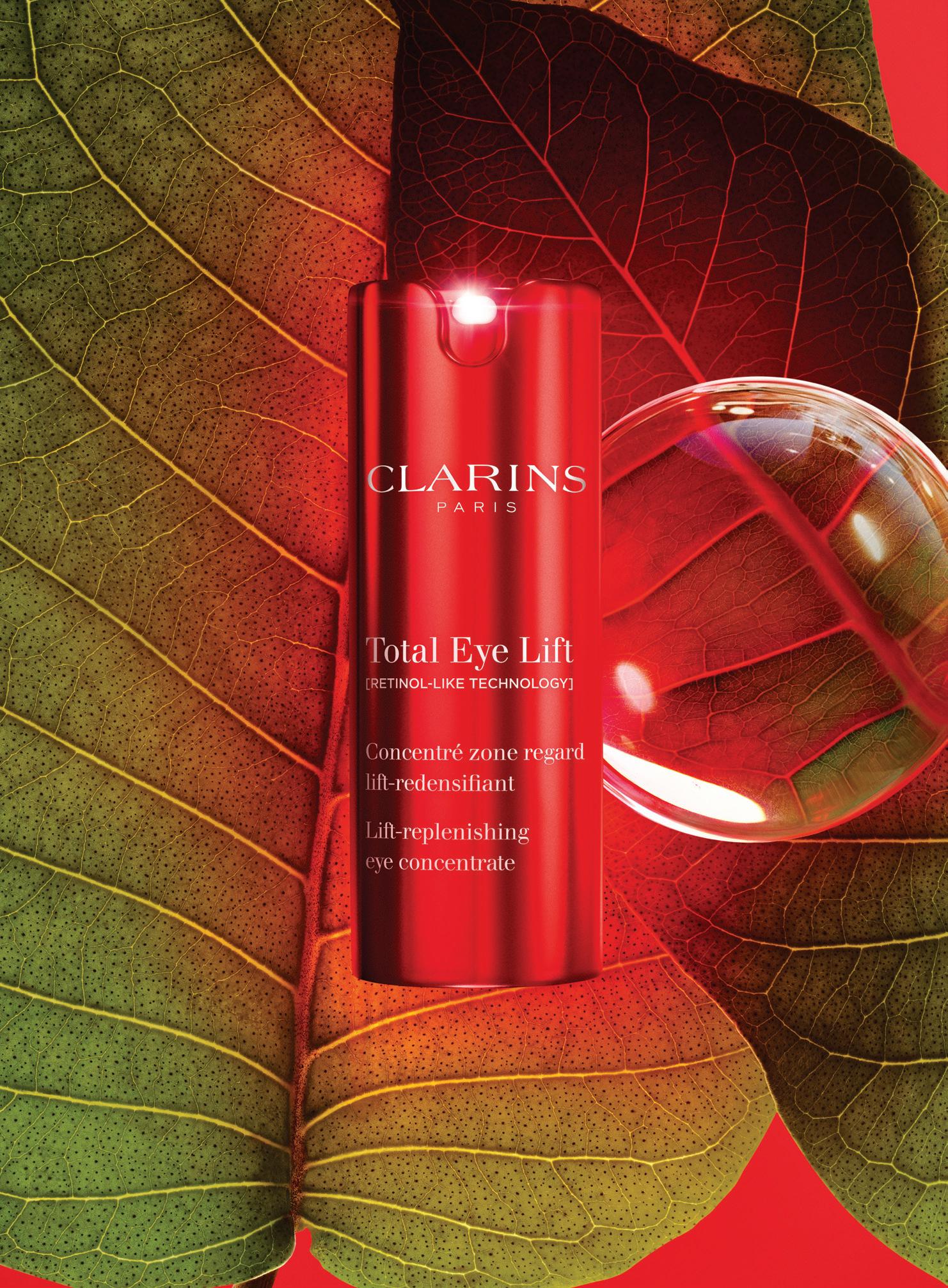
Giving back with love
A CHANCE BID AT AN AUCTION WAS THE START OF LEIGH ORD’S FRAGRANCE JOURNEY WITH SOUTH AFRICAN MASTER PERFUMER
TAMMY FRAZER, AND AN OPPORTUNITY TO GIVE BACK
WORDS JACQUIE MYBURGH CHEMALY
One late summer evening on the verandah at Waterford Wine Estate near Stellenbosch in the Western Cape, the Vintage with Love team was sharing spritzes of a new, fresh, almost tropical fragrance called For My Girls.
It was the eve of a charity lunch for Vintage with Love – a platform that Leigh Ord (above left) and I founded many years ago, together with our sisters, daughters, and a legion of amazing girlfriends, to support education charities around South Africa.
The lunch was to be an extra special event, as we were also celebrating the launch of the fragrance that Leigh had created with Cape Town master perfumer Tammy Frazer (above right). In naming it, Leigh dedicated the fragrance to all the women in her life. In launching it at Vintage with Love, she was also ensuring that their efforts would continue to make a difference to others.
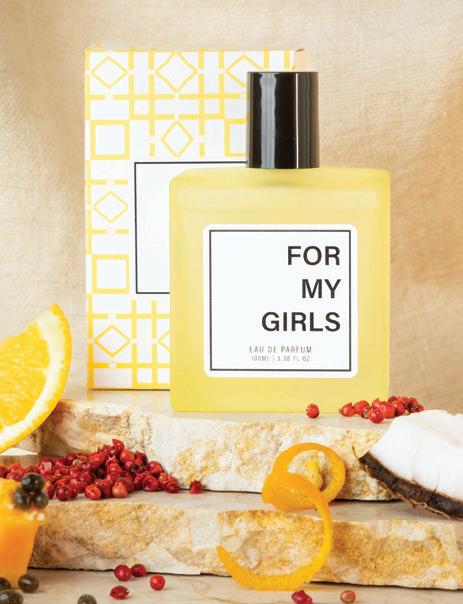

One of the most highly prized essential oils in perfumery – adding complexity and depth to fragrances in a way that few other ingredients do – rose oil is also exceedingly difficult to extract.
It took years before the first roses were harvested and tiny amounts of rose oil were extracted through a complicated process of steam distilling. In a bittersweet result, the Damascena bushes are yet to produce sufficient perfume-quality oil, but the distilling process has yielded a rose water with such a high percentage of rose oil that it is proving to be a beautiful sister to the For My Girls fragrance.
Next month, For My Girls Eau de Parfum and its sister treatment product, For My Girls Rose Water, will be launched at Skins Cosmetics, and all proceeds will go to supporting the education initiatives funded by Vintage with Love.
“She would not compromise as this was to be her gift to all the women she knows”
It all started 15 years earlier, when Leigh bid on an auction item to design a fragrance with Tammy. As they embarked on the creative process, both women realised they shared a desire to create something more than a single bottle of scent. Tammy is passionate about the powers of essential oils, and for Leigh, it extends to making a difference wherever she can. Soon Tammy and her student were pursuing that holy grail of creating rose oil – one of the most precious ingredients in any fragrance.
The two women went to Bulgaria to learn about the Rosa x Damascena and decided to import and plant 4 000 Damascena rose bushes on Waterford Wine Estate, the Ord’s family farm.
While their roses are still a work in progress, Leigh decided to continue the process of creating a fragrance with Tammy that would be an expression of her own style – and an opportunity to support the Vintage with Love initiatives.
To Tammy, Leigh was the creative director of the fragrance that became an ode to all the females in her life. “She would not compromise on anything as this was to be her gift to all the women she knows. I love that about Leigh: she is a woman in her true self, who stands up for all the women in her family; for all the women she knows.”
Leigh was adamant that For My Girls would form part of the Vintage with Love story, where once-loved fashion is collected and sold to raise funds for literacy charities. The resulting scent is as enchanting as the tale of how it came about: it features light dancing notes of blackcurrant buds with addictive coconut, leaving one wanting to smell your skin over and over. Then there is the pairing of the right flowers with a few drops of rose oil needed for it to become an accord and composition worthy of French perfumes.
For My Girls is a fragrance that has a fresh start, a floral heart and a lasting impression of papaya with the sophistication of freesias moving in the breeze. It also has meaning. ■
For My Girls Eau de Parfum and Rose Water will be available exclusively at Skins Cosmetics (skins.co.za), Waterford Estate (waterfordestate.co.za/shop/gifting), and Vintage with Love (vintagewithlove.co.za).
All the proceeds from sales will go to the education initiatives supported by Vintage with Love.

A D E C A D E of Shine
CLARINS CELEBRATES 10 YEARS OF ITS LIP COMFORT OIL WITH #THENEXT10, HONOURING 10 DYNAMIC WOMEN UNDER 30 WHO ARE REDEFINING THE FUTURE


This year marks the 10th anniversary of cult-favourite Clarins Lip Comfort Oil –a luscious blend of skincare and colour that has been on countless lips for a decade. First launched in 2015, the product transformed the beauty industry with its unique formulation: a high concentration of nourishing plant oils that deliver glossy shine, deep hydration, and an irresistible sensorial experience. Today, one Lip Comfort Oil is sold every 10 seconds globally.
To mark this milestone, Clarins launched a limited-edition shade – Iconic Red No. 54 – a bold, joyful tribute to the brand’s
founding year. This new addition, complete with its matching red cap, encapsulates the vibrant spirit that defines the brand and its loyal following. “This anniversary is about more than the product – it’s a celebration of bold femininity,” says Nthabiseng Makhokha, Clarins Communications Specialist. Clarins has handpicked 10 extraordinary women under 30 to front the campaign, each embodying courage, creativity, and modern power. From aviation to activism, and sport to skincare, meet #TheNext10.
Among them are cricketer Nonkululeko ‘Leftie’ Mlaba, creative Yewon Choi, social entrepreneur Masabata Sebusi, fashionista Georgina Bennett, and pilot Sive Mfenyana. Also featured are swimmer Jessica Thompson, influencer Lindokuhle Madlingozi, diver Constable Brooke Erin Fritz, gender activist Candice Chirwa, and culinary wunderkind Bridget Mangwandi.
With 10 radiant shades, Lip Comfort Oil continues to reinvent how women wear beauty.

Scan the QR to discover more about #TheNext10

Jessica Thompson
Candice Chirwa
Georgina Bennett
Yewon Choi
Masabata Sebusi
Bridget Mangwandi
Nonkululeko Mlaba
Constable Brooke Erin Fritz
Lindokuhle Madlingozi
Sive Mfenyana
FROM 13 RUE DE LA PAIX TO THE WORLD’S MOST REFINED WRISTS, CARTIER HAS SHAPED THE MODERN WATCH AS WE KNOW IT. FRESH FROM GENEVA, SELECT MODELS ARE NOW AVAILABLE IN SOUTH AFRICA
WORDS DEBBIE HATHWAY PHOTOGRAPHER JUDD VAN RENSBURG ASSISTANT KAYKAY RIBANE
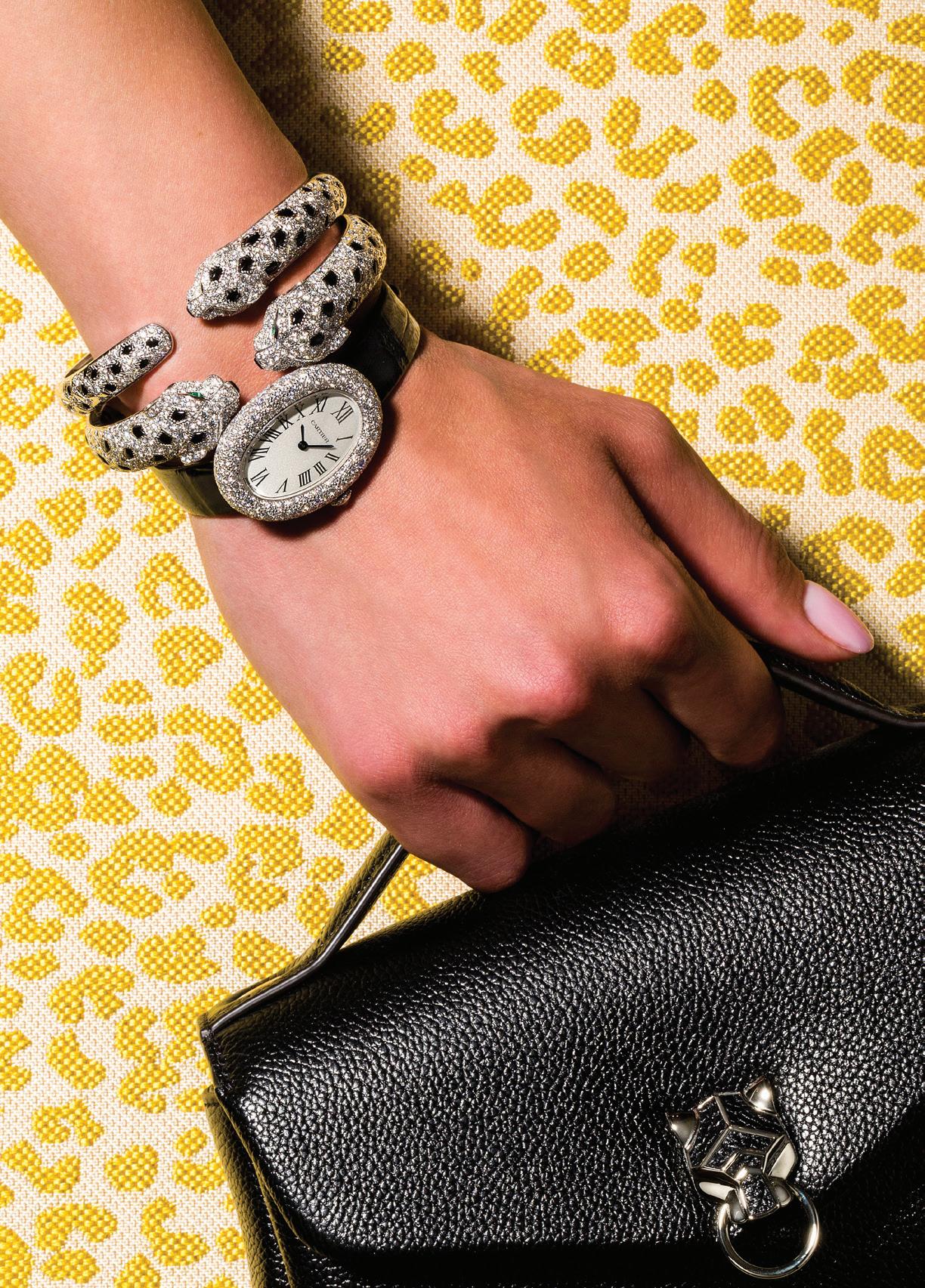
FELINE FINE
On the upper floors of 13 rue de la Paix in Paris, Cartier’s archives reveal the soul of the Maison – a place where time, style, and legacy are eternally entwined. This prestigious address was once the domain of Louis Cartier, the visionary who helped shape modern horology in the early 20th century. The building has belonged to Cartier since 1899, preserving not only precious documents but also the very essence of the brand’s aesthetic grammar.
From this creative epicentre, Louis Cartier laid the foundations for the Maison’s most iconic timepieces, fusing technical ingenuity with elegance and appointing jeweller and fashion designer Jeanne Toussaint to carry his vision into a new era.
THE INSPIRATION OF LOUIS CARTIER
When Louis joined the family business in 1898, wristwatches were still considered ornamental novelties, particularly for women. But he recognised that lifestyles were changing, and that precision timekeeping needed to evolve without sacrificing style or beauty. His vision led to the creation of watches that were not simply adapted from pocket models but designed from the ground up with modernity in mind.
A skilled strategist, the jeweller worked with movement makers like Edmond Jaeger, who in turn collaborated with LeCoultre to develop ultra-thin calibres. This alliance resulted in a 25-year exclusive contract – one of the most influential partnerships in horological history. Cartier emerged as a pioneer in design and technical refinement.
THE PANTHER WITH A VISION
In 1933, Louis appointed Jeanne Toussaint as Director of Cartier’s jewellery studio – a bold move at a time when women couldn’t even open their own bank accounts. Though not a designer in the traditional sense, she was a tastemaker and a curator of vision.
Jeanne’s fierce character and undeniable style earned her the nickname “La Panthère” (the panther, in English) – a motif that would become synonymous with the Maison. Her eye and leadership guided Cartier through the mid-20th century, ensuring every piece – from jewellery to watches – upheld the highest standards of refinement and originality.
A gift from Louis to Jeanne in 1917 – a cigarette case adorned with a panther – cemented the feline’s place in Cartier’s visual language.
NEW ARRIVALS
Each year at Watches and Wonders – the world’s most renowned watch fair – Cartier unveils a dazzling array of timepieces. And, inevitably, admirers ask the same question: how soon can they get their hands on the one that’s caught their eye?
The good news for South Africans is that the first shipment of icons has landed, and select models are now available to view or purchase at the Cartier Boutique in Sandton City, Johannesburg. Here are just a few…

OPPOSITE:
Panthère de Cartier bracelet, R2 850 000; Panthère de Cartier bracelet, double head, articulated, R3 760 000; Baignoire watch, POA; Nano Model Chain Bag, Panthère Graphique de Cartier, R54 000
ABOVE:
La Panthère Elixir; Baignoire watches, all POA
THE SANTOS
In 1904, aviation pioneer Alberto SantosDumont lamented to his friend Louis Cartier that he couldn’t easily consult his pocket watch mid-flight. Louis responded with the Santos – the first purpose-built wristwatch for men –featuring a square dial and exposed screws. Its integrated lugs, innovative at the time, paved the way for the form-driven cases that contributed to some of Cartier’s fame.
Though released in 1911, the Santos embodied the spirit of modernity, blending practicality with elegance. Its geometric clarity and visible screws remain iconic to this day. This year’s line extension includes the small Santos de Cartier model in a 27mm x 34,5mm case. It is available in steel only, steel and yellow gold, or yellow gold.
THE BAIGNOIRE
First conceived by Louis in 1912, the Baignoire’s elongated oval design was refined into the recognisable form by 1958. The name – French for “bathtub” – hints at its playful elegance, but the inspiration is said to also echo the graceful curves of opera house seating. With a dial curved to follow its silhouette and Roman numerals stretched to fit its frame, the Baignoire is a masterclass in subtle distortion and feminine refinement. Favoured by actresses like Romy Schneider and Catherine Deneuve, it remains a timeless choice for collectors seeking sculptural beauty on the wrist.

“Jeanne’s fierce character and undeniable style earned her the nickname ‘La Panthère’”

LEFT: Santos de Cartier Chronograph watch, R231 000; Trinity ring, R1 100 000; Love bracelet – small model, R620 000
BELOW LEFT: Ballon Bleu de Cartier watches, both POA; Love bracelet – classic model, R1 040 000; Panthère de Cartier sunglasses, R22 040
THE PANTHÈRE
More than a timepiece, the Panthère de Cartier (pictured on the cover) is a jewel in motion. First introduced in the 1980s, the watch became a symbol of effortless glamour. Its ultra-flexible bracelet – composed of polished square links that drape like silk – evokes the supple movement of the panther itself, a creature long associated with Cartier’s aesthetic universe.
Sleek yet assertive, the design features a square case with softened corners, Roman numerals, and blued steel hands framed by a seamless bezel. The Panthère remains one of Cartier’s most sensuous expressions, uniting the Maison’s flair for bold femininity with the architectural discipline of its watchmaking heritage. Light on the wrist but striking in presence, it’s a modern classic.
THE BALLON BLEU
Created in 2007, the Ballon Bleu de Cartier is a unisex watch defined by its distinctive, doubly convex case. Its domed sapphire crystal and integrated crown guard flow seamlessly into the rounded silhouette. Signature Roman numerals curve gently along the dial’s contours, expressing Cartier’s refined design language – subtly disrupted by the playful blue bubble of the winding crown.
MORE THAN A WATCHMAKER
Cartier’s horological journey has always been deeply intertwined with its jewellery-making heritage. Gem-set bezels, cabochon crowns, and novel clasps – such as the 1909 deployant buckle – reflect a consistent desire to marry function with finesse.
Even as Cartier pursued technical innovation, it never lost sight of beauty: from the romantic fluidity of the Baignoire to the pioneering spirit of the Santos and the feline sensuality of the Panthère.
Today, Cartier watches remain the pinnacle of horology and design, revered by collectors and cultural icons alike. The Maison’s archives bear testimony not only to the craftsmanship and vision of Louis Cartier and Jeanne Toussaint, but also to its enduring commitment to innovation – always on its own terms.
A Cartier watch is more than a timekeeper. It is an idea, a lineage, a statement –a reminder that true style never loses time. ■
Sources: Cartier Time Art: Mechanics of Passion, Jack Forster; Cartier Style and History, published to accompany the 2013 exhibition at the Grand Palais, Paris; 13 Rue de la Paix, François Chaille
CE
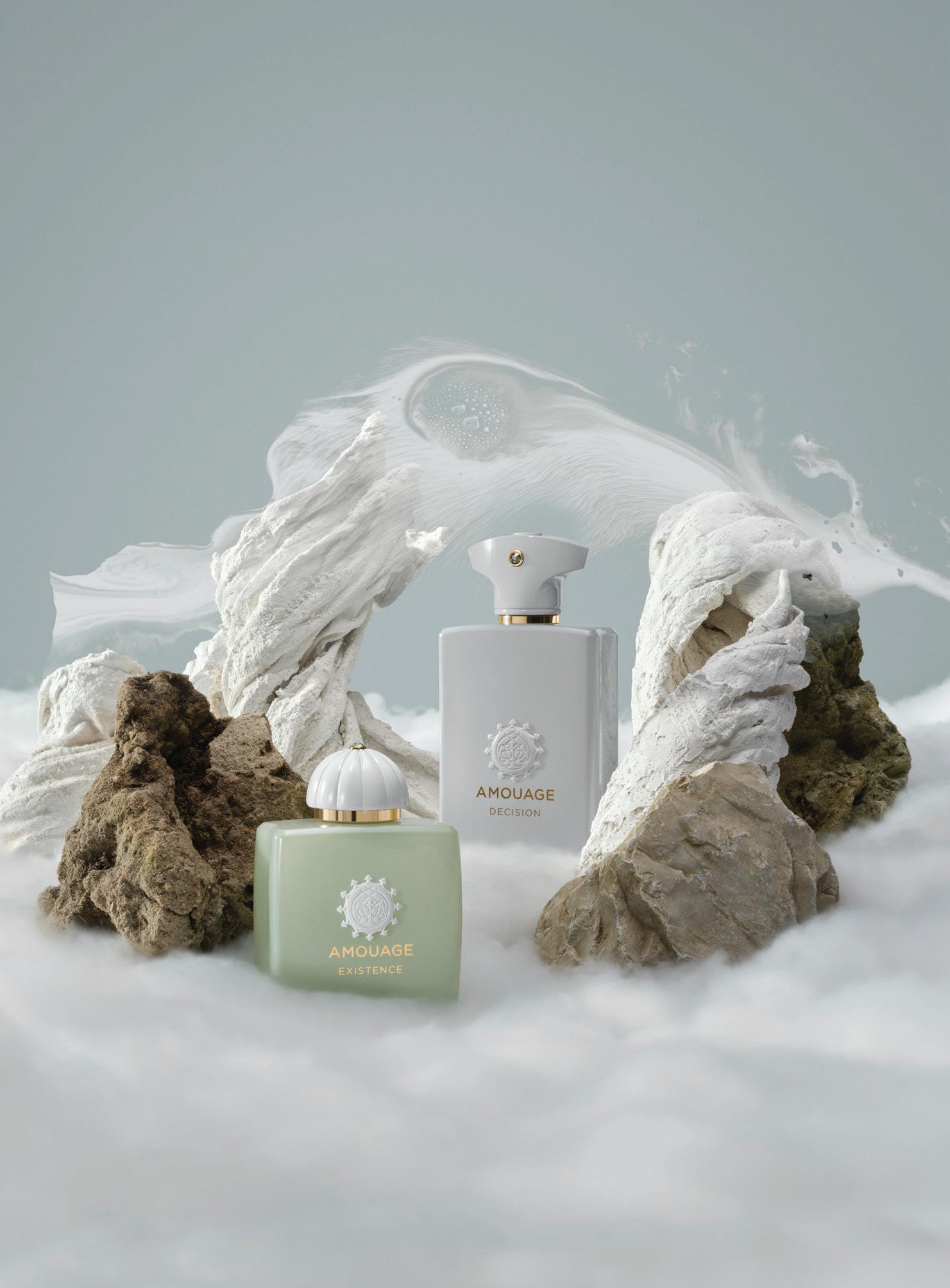

“IGilded GLAMOUR
IN AN EXCLUSIVE EXTRACT FROM CARTIER BY HELEN MOLESWORTH, WE HIGHLIGHT THE MAISON’S ICONIC MANCHESTER TIARA AND HOW IT DEFINED A NEW SOCIAL ORDER AT THE TURN OF THE 20TH CENTURY
n 1847 Louis-François Cartier (1819–1904) took over the business of his mentor, Adolphe Picard, and founded a Parisian firm that would one day be recognised the world over. He already had high aspirations for the business and within just one year could already count Princess Mathilde, the niece of Napoleon I, among his clients, and not long after, the Empress Eugénie herself. His son Alfred (1841–25), who took over in 1874 at the age of 33, understood the importance of networking for the sale of the jewels, watches and objets in the boutique (he would ask existing clients for introductions to more illustrious ones), and laid further foundations for his three sons to build on in the years to come. He made the eldest, Louis (1875–42), but not before he had married into the successful Worth family of couturiers, which exposed the firm to a yet greater international client base. Encouraged by Louis, they moved premises the following year from the boulevard des Italiens to the more exclusive rue de la Paix, next door to the House of Worth and round the corner from the luxurious Ritz Hotel, which had just opened to great acclaim as the world’s first hotel with a bath, a telephone and electricity in each room.
The Maison Cartier was now firmly positioned in Paris, and already capitalising on the world around it through social networking, strategic intermarriages and making the most of its prime location.
While it reacted to the times, it would also prove in many ways to be ahead of them, and with Louis’s two brothers, Pierre (1878–1964) and Jacques (18841941), waiting in the wings, the family would soon be ready to take the business to the next stage.
With the 1900s came a new era for Cartier and a new order for the world.
The previous century had ushered in massive global change, with electric lighting, steamboats and train travel, and swift economic growth. Such rapid industrialisation had created an era of stability, but also of social mobility, with a new class of nouveaux riches, whose goal was to rise to the top with the help of their newly acquired wealth and the networking that money afforded them. The Belle Époque in Europe was outstripped only by the Gilded Age in America, where the concentration of fresh wealth saw the adoption of distinguished and traditional European aesthetics as a means of social validation.
Hundreds of so-called ‘Dollar Princesses’ married into the British aristocracy, swapping their new American money for old British titles. In jewellery, technical and artistic change was also underway.
Recently discovered and plentiful diamond deposits in South Africa were paired perfectly with platinum, a light but tensile metal whose application in jewellery Cartier was instrumental in advancing.



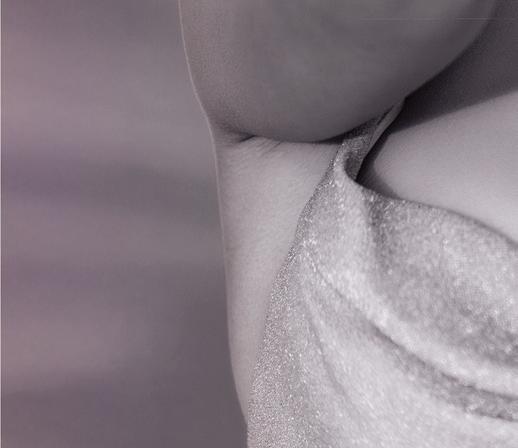









WINGS






Together, they were worked into delicate openwork designs in a ‘new style’. The Garland Style, with its French neoclassical inspiration, was a breath of fresh creative air among all the winds of change.
It was into this environment that the magnificent Manchester tiara came into being. Commissioned from Cartier Paris in 1903 by the Dowager Duchess of Manchester, it captured the zeitgeist of the age. The Duchess – born Consuelo Yznaga in New York –was a Cuban-American heiress to a new fortune who had, some 27 years earlier, married the Viscount Mandeville, British aristocrat and heir to the Duchy of Manchester. Her family were friends with the Vanderbilts (her namesake, Consuelo Vanderbilt, was her god-daughter) and were ensured a place in society through their daughter’s marriage into the British aristocracy. Consuelo would go on to become a successful society hostess, part of the close circle of the Prince of Wales, later King Edward VII, and latterly had even entertained Tsar Nicholas II. Already widowed some 10 years when she commissioned the tiara, she had recently come into her own money with the death of her brother in 1901, and the order must have to some extent symbolised the freedom this accorded her. It was also a metaphor for the times, emblematic of the turning of the new century: new diamonds sparkling in the electric light, glittering on the head of a member of an entirely new social class.
The design – a series of sweeping arcades appearing as open flaming hearts – was inspired by the ironwork and architecture of eighteenth-century France and executed by the Parisian workshop Harnichard for Cartier. The Duchess herself provided more than a thousand brilliant-cut diamonds, and Cartier supplied – unusually – glass pastes (‘strass’ in the record books) for the final scrolls at the back. Equally unusually, the stones were set not in platinum – as the lightness of design and moment in time would have suggested – but in the slightly older combination of silver (for the diamonds at the front) and gold (at the back). From a cursory glance, one would be certain it was a platinum mounting, and a similar tiara, made up for the Countess Moy six years later, is recorded in the Cartier Archives with exactly that. The Manchester tiara setting, like its owner, represented the transition from old to new, past to present, but also with a hint of the future. ■






























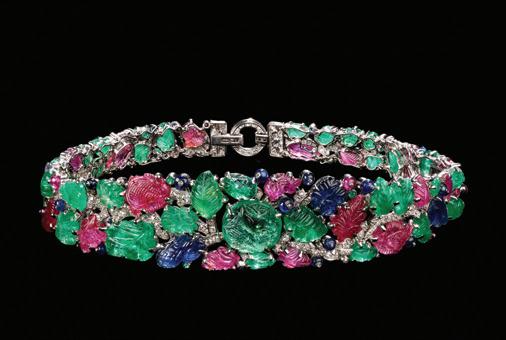


“Helen Molesworth is the Senior Curator of Jewellery at the V&A Museum in London, and the Cartier exhibtion is on until 16 November (vam.ac.uk). Cartier is available for R1 750 from amazon.co.za. Distributed by Jonathan Ball Publishers.















































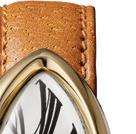

















































“The Duchess herself provided more than a thousand brilliant-cut diamonds”








OPPOSITE: Tiara, Cartier London, 1937 LEFT, TOP TO BOTTOM: Late Art Deco period brooch, Cartier London, 1941; Patiala Necklace, Cartier Paris, 1928; Bandeau in Tutti Frutti style, Cartier London, 1928; Brooch, Cartier London, 1933 ABOVE, TOP TO BOTTOM: ‘Model A’ Mystery Clock, Cartier Paris, 1914; Crash Wristwatch, Cartier London, 1967; Diamond brooch, Cartier Paris, 1910; Burmese jade necklace that belonged to American heiress Barbara Hutton. Cartier Paris, 1934; Manchester Tiara, Cartier Paris, 1903




TheS i cil yEf f ect

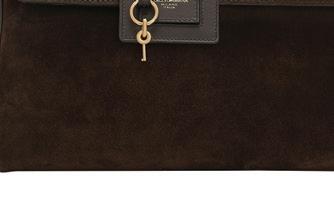
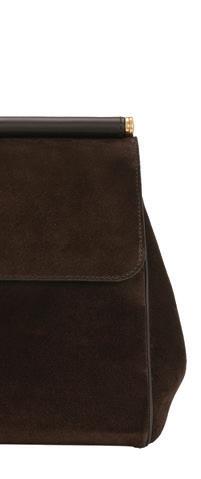
Sicily – its rich history, vibrant culture, and breathtaking beauty – has long captured the hearts and imaginations of tourists, television producers, movie stars, and fashion lovers.
Designers Domenico Dolce and Stefano Gabbana, renowned for drawing inspiration from their Sicilian heritage in their forwardthinking creations, once again pay tribute to the soul of the Italian island, reimagining a timeless fashion icon and a new approach to personal style.
NEW NAME, NEW SPIRIT
More than a luxury accessory, the My Sicily bag reflects an evolving sense of individuality. First introduced in the Spring/Summer 2009 collection, the original design embodied the Sicily’s seductive allure – its beauty, mystery, tradition, and colour. Now, My Sicily has been tailored to suit today’s cosmopolitan lifestyle; a bold statement of character, deeply rooted in the island’s heritage and values, and reimagined through a contemporary lens.
ARTISANAL TRADITIONS
Crafted from plongé lux leather, the updated bag exemplifies the exquisite Italian craftsmanship that has been passed down through generations. Softly sculpted design and intricate details create a timeless everyday look that mirrors the preservation of the island’s traditional artisans and crafts.
Practical and stylish, Dolce&Gabbana’s My Sicily bag is an expression of the island’s spirit – an evolving icon that honours tradition while creating something entirely new.

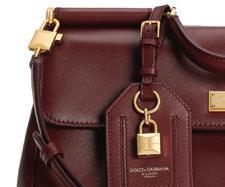





The Dolce&Gabbana My Sicily bag is available now in stores and online. You can personalise your bag’s tag at the Johannesburg Boutique in Sandton City.
of becoming THE ART

IN A WORLD THAT SUBSCRIBES TO THE CULT OF YOUTH, THREE SOUTH AFRICAN CREATIVES
PROVE THAT TIME DOESN’T DULL CREATIVITY; IT REFINES IT WORDS RYAN ENSLIN
If we’re honest, somewhere deep in our collective psyche runs a cultural obsession with youth – a fixation that’s become a stand-in for relevance and worth. In many ways, youth is the mirror we hold up to avoid facing time, change, and the inevitability of ageing. We harbour a quiet discomfort with impermanence, and a silent unease with the natural, relentless passage of life itself. But as Miles Davis once said, “Sometimes you have to play a long time to be able to play like yourself.”
Look beyond this cult of youth and you’ll find that the creatives whose impact only sharpened with time have always been there. Iris Apfel reshaped fashion well into her 90s. Know any other names who signed with a global modelling agency at the age of 97? Toni Morrison’s most powerful novels were written in her 60s. Morgan Freeman’s defining roles came after he turned 50.
Yet their stories aren’t anomalies; they are reminders that creativity isn’t tethered to youth. Creativity deepens and flourishes with time. South Africa, too, holds its own in this timeless chorus of creative longevity, a testament to how relevance doesn’t fade, it deepens. In these three creatives, we find voices which quietly remind us that creativity was never the sole domain of the young. Their lives offer a gentle defiance against the idea that creativity fades with age. In a world so easily seduced by the shimmer of the new, their stories remind us that mastery, meaning, and relevance are the gifts of a long becoming.
yourluxury.africa



PAT MAUTLOA
VISUAL ARTIST
Born in the North West Province’s Ventersdorp in 1952, Kagiso Patrick Mautloa moved to Soweto as a child, where his creative spark was ignited by the ingenuity of township life. Despite living under apartheid rule, he found early encouragement at school, where his artistic aptitude was recognised. While working as a graphic designer at the SABC, he continued to develop his art after hours.
In 1985, he co-founded the Thupelo Workshops, a seminal initiative that seeded artistic possibility and community, allowing black artists to work freely, which he describes as “liberating.” That same spirit led to the founding of the Bag Factory in downtown Joburg in 1991 – the original studio he still works from today.
With recent exhibitions at Johannesburg’s Goodman Gallery and last year at the Ljubljana Biennale in Slovenia, Pat isn’t looking back; he’s still creating, sharpening over time.
Now in his 70s and shaped by years of making, his practice hasn’t slowed. “The urge is stronger now; with age, you gather knowledge and you return to your essence.”
He remains energised by emerging artists at the Bag Factory. “My staying young, I owe to this place,” he says. “Art changes humanity, it helps people access one another’s way of thinking.” Maybe that is art’s most enduring offering: not just a bridge across generations, but a mirror, one that lets us see ourselves, and each other, more clearly.
@kagisopatmautloa
IMAGE: RYAN ENSLIN
OPPOSITE:
Ever connected to the rhythm of Joburg, Pat Mautloa uses discarded items from the city to create inspiring artworks
LEFT:
Pat in his studio at the Bag Factory, where he still occupies the same space more than 30 years later
RUTH MOTAU
PHOTOGRAPHER
At 57, Ruth Seopedi Motau has allowed time to nurture her creative voice, giving it space to do what it does best: strengthen. She graduated from the Market Photo Workshop in Newtown, Johannesburg, where she studied under documentary photographer David Goldblatt, and went on to become South Africa’s first black female photo editor. From the beginning, her lens has been coaxed by the texture of township life, the churches, the shebeens, and the spaces in between. “If I didn’t tell those stories, no one would have,” she says.
Ruth’s work has been shown in more than 50 local and international exhibitions – a body of work that refuses to grow quiet or irrelevant. But her sights are set firmly forward. “I’m busy with a project on black beauty,” she says, her tone steady, her gaze flickering with quiet conviction. Hers is a creative voice still drawn to the urgency of stories that tug at the soul, work that refuses to stand still.

Now, her focus has widened. She mentors young black female photographers from townships and rural areas, guiding those often left without access to training or support.
“I know the challenges they face,” says Ruth, her eyes drifting to a photograph from her Shebeen series, now hanging quietly in her home.
Her instinct to uplift others echoes a deeper truth that creativity is never only about the work; it’s also about the people it reaches.
Ruth’s generosity is a quiet reminder that art reconnects us to purpose, to meaning, and one another. @seopedi_8
PAUL VAN DER SPUY
SHIRT DESIGNER & CREATIVE
Paul van der Spuy is as creatively charged as ever at the age of 76. “I design for the part of you that remembers,” he shares, his voice steady with the kind of clarity only time can hone. From co-founding Carducci to shaping cult labels like Frank B. Ernest and garnering five South African Fashion Awards, Paul has long worked at the intersection of style and soul. The Proper Store, home to bespoke pieces that continue his design ethos, is the next natural chapter in a creative life still unfolding, and operates from the Oranjezicht City Farm Market in Cape Town.
As a conceptual thinker, Paul’s creativity flows beyond design into interiors and branding with equal flair. A self-described “retrobate,” he draws inspiration from eras when craft was sacred and the artisan’s hand still led. Even after four decades, reinvention remains his fuel. “It wasn’t a sabbatical,” he grins, speaking of a recent trip through India and Bangkok. “It was a creative fanatical.” The trip yielded new fabrics, trims that spoke to his soul and collaborations grounded in old-world skill – proof that his creative fire is far from spent.

Perhaps his most enduring creation isn’t a garment, but the legacy he’s shaping with his youngest of three sons, Oscar. Accompanying Paul to India, their journey became a dialogue as much as a pilgrimage, with Paul sharing every insight and lesson he’s carried since 1974. Now, Oscar outsells his father at the market, not in competition, but as a continuation. Mentorship, for Paul, affectionately known as the Unofficial Mayor of Cape Town, is less a role than a lifelong rhythm, a thread linking him to countless thinkers, musicians, and makers drawn into his orbit. @lateralpaul ■
ABOVE: Ruth Motau in her studio space in Johannesburg
LEFT:
Paul van der Spuy at the Oranjezicht City Farm Market, where he sells his latest line of bespoke clothing items, The Proper Store
IMAGE: SANTA STRAUSS
IMAGE: RYAN ENSLIN

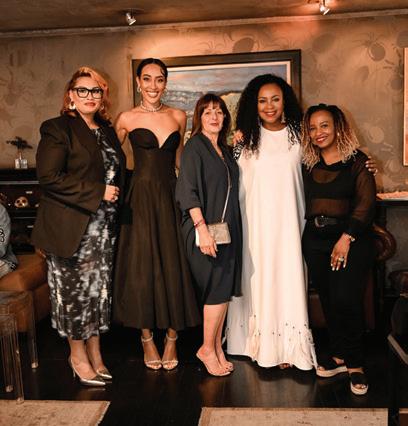
PRIVATE CLIENTS BY
Private Clients by Old Mutual Wealth provides holistic, bespoke solutions for high-net-worth clients, partnering with specialists to create integrated plans encompassing investments, wealth structuring, tax efficiency, and portfolio administration. Our personalised approach sets us apart, supported by a strong track record in wealth and investment management. As part of a brand with nearly two centuries of heritage and decades of hands-on experience, we help individuals, families, trusts, and entrepreneurs navigate, grow, and protect their wealth across generations.

next generationEnabling the ofFamily Wealth
HOW WOMEN ARE SHAPING LEGACIES THROUGH THE MODERN
WFAMILY OFFICE
omen are the cornerstone of families – and they are increasingly becoming the foundation of generational wealth. For decades, the financial services industry has not been structured in a way that speaks meaningfully to women, but now, the family office model is changing that.
More than just a financial hub, a family office offers a deeply personal, purposedriven approach to managing wealth. It ensures that a family’s financial affairs are aligned, cohesive, and tailored to its values, enabling wealth to transition seamlessly across generations.
Sarette van den Heever, Family Office Wealth Director at Old Mutual Wealth, explains that the services provided range from managing global tax structures and investments to overseeing governance and administration, and even mediating complex family conversations. Rather than operating in isolation, family offices collaborate with external experts and trusted advisors, integrating existing client relationships with auditors, lawyers, and tax professionals across jurisdictions.
At the heart of this approach is preparation – equipping the next generation to become thoughtful custodians of inherited wealth. Sarette emphasises the importance of younger family members understanding both the origin and aspirations of the wealth in order to better protect and maintain the legacy –while also pursuing their own goals, such as managing a family business or creating new ventures. A family constitution often formalises these shared values, roles, and visions, helping families navigate the evolving dynamics that come with growth and change.
With globalisation, managing wealth internationally has become essential. Families today are increasingly mobile, and often spread across continents, with assets, businesses, and interests in multiple jurisdictions. Offshore diversification not only supports better returns and risk management, but also accommodates younger members living or studying abroad, as well as retiring parents relocating closer to their children.
Women are – and have always been – pillars of society, business, and wealth. By partnering with a family office, they are empowered to help their families preserve and grow its wealth in a way that supports their family’s future, and honours its past.
wealthprivateclients.co.za
Stellenbosch: 021 861 5300; Newlands: 021 524 4678; Johannesburg: 011 245 3805; Pretoria: 012 369 7236; KZN: 031 767 7300; George: 082 823 2731
OLD MUTUAL WEALTH
Sarette van den Heever
TWO SOUTH AFRICAN TRAILBLAZERS REVEAL WHAT IT MEANS TO BE YOUNG, AFRICAN, AND DEEPLY ROOTED IN LEGACY
WORDS AMONGE ELETHU SINXOTO
In an era where innovation is often synonymous with disruption, two young African creatives, Liyema Letlaka and Makomborero Mutezo, are proving that youth isn’t a barrier to excellence, but an amplifier of vision and ingenuity on a global stage.
At just 23, Liyema is reshaping the future of motorsport through the South African Endurance Series, while 24-year-old Makomborero’s successful enterprise, TheHungryMute, is making waves in the food world with his handmade brownies that are as intentional as they are decadent.

LIYEMA LETLAKA CEO, SOUTH AFRICAN ENDURANCE SERIES
At an age where many of us barely know which direction our lives will take, Liyema is redefining what leadership looks like in the high-octane world of motorsport. Her journey began in the paddocks –quite literally. She started racing at 10 years old, often the only girl – let alone

the ofageARRIVAL
black girl – on the track, competing against much older boys. Her introduction to motorsport wasn’t only driven by passion; it was inherited. Her father, Xolile Letlaka, a trailblazer in his own right, built South Africa’s first allblack endurance racing team, claiming space in a historically exclusive sport.
Professionally, Liyema started by assisting with logistics and operations behind the scenes, gaining hands-on experience within the South African Endurance Series (SAES). From those early support roles, she worked her way up, demonstrating a deep understanding of both the sport and the culture around it. In just a few years, she advanced to roles in strategy and communications, and eventually to her groundbreaking appointment as CEO of SAES at only 23 years old. Her leadership is rooted in vision, but also in lived experience, having witnessed first-hand the structural limitations of the sport.
“Motorsport has always been my passion,” she says. Even after a serious accident at 13, which momentarily kept her away from competing, her attachment to the sport never faded. She admits that while fear kept her from returning to racing, her drive found a new outlet. “I always knew I wanted to be in the sport; I just didn’t know how.” Stepping into the CEO seat
is not a fluke – it’s a continuation of the path she’s been walking her whole life. Under her leadership, SAES isn’t just evolving, it’s becoming a catalyst. She advocates for educational outreach, partnerships with schools, and increased STEM pathways to bring more young people into motorsport – not just as drivers, but as engineers, dietitians, and technicians.
Liyema shared her mission to blend strategy and spectacle, expanding motorsport’s reach through storytelling, accessibility, and a distinctly African identity. “We’re modernising, but I want it to still feel rooted in South Africa,” she says. She speaks excitedly of the Kyalami racetrack’s upgrade to FIA Grade 1, seeing it as an opportunity for SAES to align itself with global motorsport standards and gain visibility.
Her youth is not a liability; it’s a distinct strength. She’s fluent in the languages of digital culture, inclusion, and innovation – qualities that are vital to SAES’s evolution. Whether she’s championing heritage car classes or pushing for polished, FIA-standard race operations, her leadership is precise and progressive.
“Success is making space for people who look like me,” she says. With plans to integrate the SAES into a global motorsport narrative, she’s racing towards a future where Africa doesn’t just participate in elite motorsport –it defines it. @liyema.letlaka










































“African ingredients and culinary storytelling deserve to sit comfortably within the luxury space”

MAKOMBORERO MUTEZO
FOUNDER,THEHUNGRYMUTE
Makomborero is a name you won’t forget – not because he recently won the Capitec Rising Star Award at Decorex Cape Town, but because his brand, TheHungryMute, is changing the flavour of luxury, one brownie at a time. The pastry chef is also a designer, thinker, and cultural archivist whose work lives at the intersection of food, memory, and African expression.
Makomborero’s design ethos was sharpened during a formative moment in Europe. Sitting outside a café in Germany, he watched completely different people interact with the same croissant: a child lit up at the packaging, a family appreciated the gesture of a small gift, a homeless man was served with dignity, and a student smiled at the familiarity of the offering. In that single moment, Makomborero became aware of the way a single product could carry multiple meanings depending on how it was presented, who received it, and the emotion it carried. This became central to his business philosophy: to not only make good food, but to design every element of the experience. “I chose the brownie because it was a way I could uniquely translate my pain points: shelf life, branding, art direction, and packaging. But also, I love chocolate and I love cake. Why not combine the two?” he beams.
At the heart of TheHungryMute is a belief that African ingredients and culinary storytelling deserve to sit comfortably within the luxury space. Makomborero sources premium African-grown produce and blends it with techniques drawn from both fine dining and street culture. His design training also gives him an edge: he creates his own packaging, brand visuals, and even the print artworks. His brownies are more than sweet treats; they’re design statements wrapped in carefully curated packaging layered with narrative.

From a Pitori Chippie Box that nods to Pretoria’s cultural legacy to limited-edition artworks that double as collectables, each bite is a multi-sensory experience.
And his Capitec Rising Star Award win at Decorex? “I cried,” he admits. “It validated all the sacrifices.” Makomborero is committed to expanding his brand, experimenting with product packaging, prints, and pop-ups that combine food and design experiences. He plans to invest the prize money into infrastructure, process improvements, and building scalable solutions for his growing audience, continuing to push African luxury into new forms.
“Timelessness,” he says, “is built through consistency, memory, and care.” @thehungrymute ■

If you are interested in buying or selling Fine Art, Decorative Arts, Design, Jewellery or Furniture, visit www.straussart.co.za for more information on valuations, sales, upcoming exhibitions, talks and more.
CONTACT
Valuation enquiries contact art@straussart.co.za
Private Sales enquiries contact kirsty@straussart.co.za
General Enquiries: jhb@straussart.co.za | 011 728 8246 or ct@straussart.co.za | 021 683 6560

Marc Chagall , La Baie Des Anges, 1962 (detail); R350 000 - 500 000

ON A TRIP TO TURIN FOR THE 50 BEST RESTAURANT AWARDS, INGA SIBIYA DINES AT TWO OF ITALY’S FINEST CULINARY DESTINATIONS


ITALIAN the job
My love affair with Italy began in my imagination. Consumed by Elizabeth Gilbert’s version of the country, I vowed to have my Eat, Pray, Love moment – which I got in my early 20s during a family vacation. Exploring Italy through food was the kind of adventure I’d had on trips before this, but never with the same intention.
And so, earlier this year, when I was presented with the opportunity to return to the cobbled streets in northern Italy’s Turin for the 50 Best Restaurant Awards, I was beside myself with excitement. Returning to a culinary culture that is colourful, resourceful, and generous in its simplicity felt like a full-circle moment.
I believe the way people gather round a table tells you a great deal about their way of life. It’s about more than the food – it’s an invitation to immerse yourself in a rich tapestry of history and society. Having spent four weeks exploring Italy, it was the avant-garde creations at Locale Firenze in Florence and the timeless elegance of Oro at Belmond Hotel Cipriani in Venice that brought the unparalleled culinary artistry of Italy to life for me. What lingered most, long after the final course had been cleared, was how deeply personal the experience felt.


LOCALE FIRENZE
Walking to Concini Palace, the 16th-century home of renowned restaurant and bar Locale Firenze, the tone is firmly set for the evening as we pass attractive locals in beautiful bars enjoying afterwork drinks. The area is hip, contemporary, and trendy.
Arriving at Locale Firenze’s bar – ranked 36 in the World’s 50 Best Bars in 2024 – its juxtaposition of an ornate tableau of history with modernist mixology techniques and a future-thinking menu, is sublime. Choosing from a shortlist of signature cocktails comes down to a simple matter of taste, as they are all distinctive. “I will always suggest that people not from the region try our cherry wine, but maybe you have that as your digestif at the end of your meal,” says mixologist Allessandro Mengoni. Grappa tends to be too strong for me, so I follow his recommendation, choosing to start with the Foglia - a gin, hemp, mint, basil, and lemon cocktail. My espresso-loving husband goes for the conspicuously named Coffee Tonic, a rum-based cocktail with coffee kombucha.
After welcome drinks at the lively bar, we are seated in the cellar, which is said to have been built in the 1200s. “Unless there are any specific




dishes you’d like to try, our desire is to take you on a tasting journey,” explains our waiter, Nicola, “Chef Simone Caponnetto [above] has selected a few to enjoy with a wine pairing.”
Every dish has been painstakingly perfected. The fusillone pasta dish looks like a Jackson Pollock painting, but each mouthful proves that the different sauces have been arranged on the plate with intention. The textures and flavours of saffron, cuttlefish, and herb jus fuse elegantly.
Trilogia D’uovo is the highlight of the evening. Every element exists in perfect harmony, from the caviar that softens the palate in anticipation of the crostini’s crunch, to the smooth richness of an egg yolk sitting atop a tart sauce that cuts through an otherwise generous mouth coating. Cured fish and smoked cream also make the perfect pair on a charred crisp.
Chef Simone gives diners an evocative gastronomic experience that’s divided into three acts. Dining here is an eclectic and exciting experience, a symphony of flavours that honours history in the most inventive and contemporary ways. localefirenze.it
“Every element exists in perfect harmony”
ORO
AT HOTEL CIPRIANI
A BELMOND HOTEL
By stark contrast, the one-Michelin-starred restaurant, Oro, is the epitome of traditional Italian dining in a luxurious setting. Sharing Venice’s legendary Hotel Cipriani with three other restaurants, it stands out because it tackles complex concepts with simple executions. This leaves very little room for fault.
Conducting culinary art from national staples and personal experience, Chef Vania Ghedini (above left) and Chef Massimo Bottura achieve this by starting at the source. “We grow a lot of our staple ingredients ourselves so that we can manage the quality of our produce, from asparagus to artichoke, and with other fruits and vegetables,” Vania explains.
Our meal started with what appeared to be an antipasto of fish carpaccio. The burst of refreshing and herbaceous flavours proved, however, that it was anything but. We then moved on to the tortellini, which is at the heart of the seven-course tasting menu. Every mouthful of pasta yields after a little resistance to mussels, soft-shell crab, and scampi. This is followed by a golden-fried oyster on an egg, bacon, and Parmesan foam that has a thick squid-ink foundation.
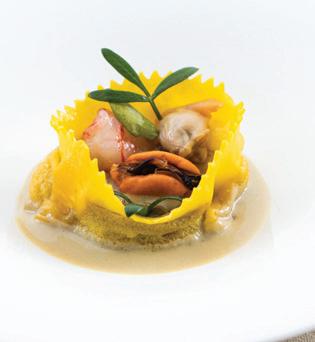
A delicate tiramisu caps our meal. Two cocoa-dusted, wafer-thin crescents filled with mascarpone cheese and a coffee-flavoured Italian custard flank a gold-leafed cylinder of the same in the middle. Simple, striking, and almost too beautiful to eat. Almost. belmond.com ■
THE NEW AFRICAN GETAWAYS
EXPERIENCE THE UNCHARTERED MAGIC OF AFRICA WITH KIGALI’S GREEN INNOVATION, SALIMA’S LAKESIDE BLISS, AND OUAGADOUGOU’S BOLD ARTISTRY
WORDS INNOCENT NDLOVU


WHAT TO SEE
Designed by French architect René Faublée, La Maison de Peuple – one of the country’s most significant landmarks – is famous for its striking African modernist design and influence. Opened in 1965, it stands as a symbol of democracy and serves as a venue for congresses, exhibitions, festivals, and concerts.
WHAT TO DO
Explore the Musée National Du Burkina Faso to discover artefacts, traditional masks, bronze statues, and archaeological treasures. It’s an engaging way to learn about Burkinabé traditions and history.
OTHER ATTRACTIONS: The Cathedral of the Immaculate Conception (top) and a monument at La Place des Cinéastes (left)

Impromptu strikes at the Louvre in Paris, tourists being doused with water while dining in Rome, and digital nomads swarming Cape Town – travellers are flocking to the same hotspots year after year, leading to these inevitable incidents. In fact, according to National Geographic, 80 percent of travellers only visit 10 percent of the world’s tourism destinations.
Overtourism invariably results in local communities, businesses, and workforces being overwhelmed by the demand and high number of visitors. Cities like Kyoto in Japan, Amsterdam in the Netherlands, and Italy’s Amalfi Coast, for example, have all been affected by an influx of travellers in recent years, often leading to unsustainable tourism, overcrowding, and price hikes at restaurants and hotels.
While Africa boasts many famous tourist attractions that draw crowds from around the globe, the continent is also home to some of the most magical lesser-known marvels. These hidden gems often fly under the radar and are easily overlooked, yet they offer equally thrilling experiences. Rwanda’s Kigali, Salima in Malawi, and Ouagadougou in Burkina Faso offer a combination of breathtaking views and exquisite culinary delights, making them incredible places to visit.
OUAGADOUGOU BURKINA FASO
THE LAND OF THE UPRIGHT PEOPLE, FAMOUS FOR ITS POLYRHYTHMIC MUSIC
Renamed in 1984 by Thomas Sankara – often referred to as Africa’s Che Guevara – Burkina Faso has a vibrant tradition of artisanal craftsmanship and innovative vernacular architecture. Ouagadougou, the capital city, is like an open-air museum, merging local traditions with contemporary flair.

WHERE TO STAY
Azalaï Hôtel (above) is a grand hotel conveniently located close to the airport and the city’s main attractions. A scenic courtyard opens onto a pool and garden, and the rooms are decorated in a stylish postmodern design. azalia.com
WHERE TO EAT
La Cascade’s mix of local, regional, and international cuisines makes it a go-to for both residents and international travellers. Known as a culinary gem, it serves hearty meals with key ingredients like peanuts and sorghum. @restolacascade
Le Bistrot Lyonnais offers excellent service, a prime location, and delicious meals – all guaranteeing a memorable experience.


SALIMA (LAKE MALAWI), MALAWI
THE WARM HEART OF AFRICA
Straddling three countries – Malawi, Mozambique, and Tanzania – Lake Malawi is the third-largest lake in Africa. This UNESCO-listed site is home to multiple tiny, secluded islands, which are mostly uninhabited and remain preserved in their natural state.

WHERE TO STAY
Blue Zebra Island Lodge (top, right, below right) on Nankoma Island in the Lake Malawi National Park combines adventure with relaxation. Choose a secluded chalet or safari tent, unwind at the infinity pool, and enjoy boat cruises and walking trails. bluezebra.mw
WHERE TO EAT
ZATHU Cape Community Kitchen & Bar in Cape Maclear is well known for its traditional Malawian dishes, such as chambo (considered Malawi’s best freshwater fish) and bombe, a type of catfish, both served with nsima (a maize porridge similar to pap, below). @zathu_kitchen
“Lake Malawi is a haven for birdwatchers”

WHAT TO SEE
Home to hundreds of species of birds, the lake is a haven for birdwatchers. These include the powerful African fish eagle and the elusive African pitta.
WHAT TO DO
Mumbo Island’s pristine surroundings and crystalclear waters provide an unforgettable aquatic experience. Think snorkelling, sailing, and scuba diving among hundreds of unique cichlid fish native to the lake.






WHAT TO SEE
But it’s not all nature and lakeside towns. Rwanda has a powerful yet tragic history that the nation has turned into a triumphant story. Travellers can start their cultural tour by visiting the Kigali Genocide Memorial for a profound look at the 1994 genocide, in which more than 800 000 people lost their lives. Today, the site stands as a symbol of reconciliation, understanding, and empathy. kgm.rw
WHAT TO DO
If trekking to see the gorillas sounds like an extreme sport to you, try horseback riding on Mount Kigali –an excellent way to enjoy the scenery and panoramic views of the city.

KIGALI RWANDA
AFRICA’S CLEANEST CITY AND A GATEWAY TO THE LAND OF A THOUSAND HILLS
Named one of Condé Nast Traveller’s Best Places to Visit, Rwanda is a one-ofa-kind country that blends urban energy with natural landscapes. Home to one of Africa’s oldest rainforests and the endangered mountain gorillas in the lush Virunga Mountains, Rwanda is a must-visit for lovers of adventure and animals.

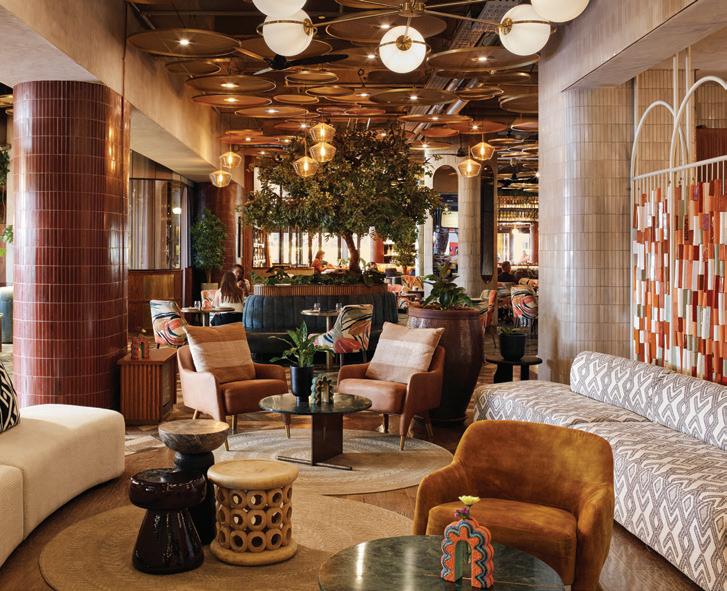



WHERE TO STAY
Hôtel des Mille Collines (above) – the historic establishment that inspired the 2005 film Hotel Rwanda – has plenty to keep guests entertained, including a restaurant serving highly rated signature dishes. millecollines.rw
WHERE TO EAT
In Rwanda, coffee isn’t just a drink – it’s a tradition. Head to Indabo Café (left), an open-air restaurant serving locally brewed coffee with a fresh local menu. Question Coffee is another standout café, operating as a social enterprise, and offers master classes, craft workshops, and guided coffee tours. @indabo_cafe; @questioncaferw ■
A BIT OF CULTURE: Choose Kigali (top left) and Heaven Art Gallery (above) are must-visit galleries for art lovers


DESIGN
of the times
AT HYDE JOHANNESBURG ROSEBANK, A FEMALE-STRONG TEAM
MERGES URBAN COOL WITH SIGNATURE SOUTH AFRICAN STYLE


“The hotel balances urban sophistication with local creativity”

Set in the iconic Bank Building in the heart of one of the city’s most vibrant neighbourhoods, Hyde Johannesburg Rosebank – Hyde’s first African property – is an award-winning destination for both business and leisure travellers.
With 131 bohemian-luxe rooms, the hotel balances urban sophistication with local creativity. But Hyde Rosebank is defined by more than its luxurious spaces, effortless comfort, and exceptional service. The hotel is an inspiring reflection – and celebration – of femaleforward leadership. This includes General Manager Jessica Redinger, Sales and Marketing Manager Michelle Bingham, Financial Manager Mbali Zungu, and Rooms Division Manager Charity Mbuza.
Additionally, Proud Mary, Hyde Rosebank’s popular allday eatery and wine bar, is another striking testament to the women at its helm. Head Chef Leigh-Anne Rose Knipe and Sommelier Katlego Mathobela were both instrumental in its recognition as South Africa's ‘Best Hotel Restaurant of the Year’ in the 2025 Luxe Restaurant Awards. From morning coffees and business lunches to evening cocktails and dinner dates, Proud Mary is as chic as it is welcoming.
Just steps from Proud Mary, guests can enjoy a unique Koval Distillery Tasting Flight at NPF Tasting Room, which celebrates Chicago Rye Whiskey produced by a female-owned distillery in America’s Grain Belt.
Hyde Rosebank’s commitment to celebrating women is most evident in its impressive all-female art collection, curated by Lezanne van Heerden.


Upon arrival, guests are greeted in the lobby by Liza Grobler's showstopping hanging tapestry – a masterpiece by the Cape Town-born artist who was the official curator for the 2025 Klein Karoo Nasionale Kunstefees (KKNK).
The immersive artistic journey continues throughout the hotel with works by rising stars, such as abstract surrealist Hanna Noor Mahomed and multidisciplinary artist Mbali Tshabalala. The collection extends beyond traditional mediums, featuring ceramic totems by Paloma, where artist Elsa Glansbeek's Mexican heritage injects vibrancy into every piece, and collaborative works from Ananta x Monkeybiz – founded by sisters Viveka and Rucita Vassen – whose beadwork empowers women from Khayelitsha.
From nomThunzi Mashalaba's introspective textile pieces to Lyndi Sales' scientific-meets-artistic installations, mandala prints by Manifest's Heather Burns, and bold gradient mirrors by Water Dixon's Caitlin Warther and Wendy Dixon, every artwork contributes to an atmosphere where laid-back luxury meets meaningful cultural expression. With its prime location and signature South African hospitality, Hyde Johannesburg Rosebank is the city’s most exciting destination for business and pleasure. It’s also proof that when women lead, extraordinary experiences follow.
Cradock Avenue, Rosebank hydehotels.com
ELECTRIFIED, ELEGANT, AND EXHILARATING, THESE THREE LUXURY CARS ARE REDEFINING MOTORING WITH POWER, EMOTION, AND HERITAGE IN MIND
WORDS EDWARD MOLEKE MAKWANA
In a world that’s constantly chasing the latest trends, some machines transcend time with their blend of engineering brilliance and emotional resonance. I recently had the privilege of immersing myself in three such masterpieces: the all-electric Porsche Taycan 4S, the regal Lexus LX 700h Overtrail, and the muscular Audi SQ8.
Each car represents a unique interpretation of timeless luxury – fusing heritage, power, and emotion in motion. While Porsche stirs the soul, Lexus soothes it, and Audi awakens it. These three vehicles are not only modes of transport, but manifestations of time, legacy, and the unrelenting pursuit of excellence – whether you’re chasing dreams, seeking sanctuary, or craving adrenaline.
in motion ICONS

PORSCHE TAYCAN 4S FUTURE LEGACY
When Christo Kruger, Porsche South Africa’s Group PR Manager, confirmed my Taycan 4S test drive, it felt less like an appointment and more like an audience with royalty. After all, Porsche isn’t merely a brand – it’s a bloodline.

I first ‘met’ the Taycan 4S at Porsche Centre Johannesburg, its silhouette unmistakably drawn from the marque’s iconic heritage, yet refined for the future.
From the very first turn, the Taycan 4S commanded attention. It didn’t just glide – it reigned. Heads turned slowly, reverently, as if bowing before a monarch. Inside, it was minimalist and sophisticated, offering driver experience with seamless digital interaction, intuitive operation, and bespoke personalisation.
With 447kW of power and 710Nm of torque coursing through its electric veins, this car doesn’t whisper, it sings, stirring my soul in ways only a Porsche can. Its 625km electric range redefines long-distance confidence, although Gauteng’s infamous potholes and unpredictable speed humps offer occasional reality checks.
Driving the Taycan 4S feels like poetry in motion – with motorsport pedigree and pioneering technology in perfect rhyme – a timeless classic reimagined for the electric age.
Having also driven its Audi RS e-tron GT sibling a year or so ago, I’d choose the Taycan as my secondary indulgent vehicle. It’s simply more charming, more evocative –more Porsche.
PRICING:
From R3 295 000 with a three-year drive plan, or R3 395 000 with a five-year drive plan.
LEXUS LX 700H OVERTRAIL
SUBLIME SERENITY
Few names whisper luxury with the calm assurance of Lexus. And fewer still exude such effortless majesty as the LX 700h Overtrail – the Japanese marque’s flagship SUV made for the discerning explorer.
At first glance, the LX 700h imposes with grace, but the refined growl of its 3.5L V6 hybrid engine promises a power duel with British aristocracy, particularly the Range Rover P530, which marks its 55th anniversary this year.
As I spent a few days behind the wheel, a thought lingered: “Can Japanese serenity truly rival British legacy?” In many ways, it does. Ride comfort is sublime, the engine refined, and thanks to the Adaptive Variable Suspension system, the LX absorbs rugged terrain with dignified composure – especially in Sport mode.
The hybrid system delivers 341kW of power, but its benefits are best felt in Eco mode, where fuel efficiency meets quiet luxury. The Overtrail’s design language evokes power dressed in restraint: matte grey wheels, black gloss spindle grille, and a subtle Terrane Khaki finish (or the exclusive “Moon Desert” tone). Inside, the Ash Burl Black ornamentation and monolith-themed palette create an oasis of calm.


“Each car represents a unique interpretation of timeless luxury”
The off-road credentials are real too; locking differentials, all-terrain tyres, and trail-ready specs ensure the LX is as capable as it is cultured. And in true Lexus style, it’s backed by a class-leading seven-year/100 000km warranty.
For connoisseurs who seek Japanese omotenashi hospitality, minimalist beauty, and robust refinement, the LX 700h Overtrail is a compelling contender. But be warned: comparing it to a Range Rover will lead to sleepless nights.
PRICING:
From R2 703 600 with a seven-year/100 000km warranty that is extendable to 10 years, and unlimited for hybrids.
AUDI SQ8
POWER PERFORMANCE
After the serene elegance of the Lexus and the electric majesty of the Taycan, I found myself behind the wheel of the unapologetically assertive Audi SQ8 – a sporty SUV coupe that roars with confidence and glows with Audi’s enduring design ethos.
Draped in Chili Red metallic paint and seated on massive 23-inch alloys, the SQ8 makes no attempt at subtlety. It’s here to perform. And it does – spectacularly –thanks to a 4.0 TFSI V8 engine pushing 373kW of power and 770Nm of torque. From 0 to 100km/h in just 4.1 seconds, this is athleticism dressed in a tailored suit.
What sets the SQ8 apart, however, is its dual personality: it growls on ignition thanks to its exhaust flaps, yet settles into a more refined purr when cruising. With Audi’s quattro allwheel drive and fast-shifting eight-speed Tiptronic, it also carves through corners with poise and precision.
Framed against the legacy of the BMW X6, the SQ8 is Audi’s bold rebuttal – an evolution rather than imitation. And while its RS Q8 sibling offers more raw power, the SQ8 is likely all the performance most drivers will ever crave with just the right balance of muscle and power.
For those who doubted whether Audi still had its mojo, the SQ8 answers emphatically: Yes. And then some.
PRICING:
R2 640 500 with a five-year/100 000km Audi Freeway Plan, and comprehensive service and maintenance plans. ■

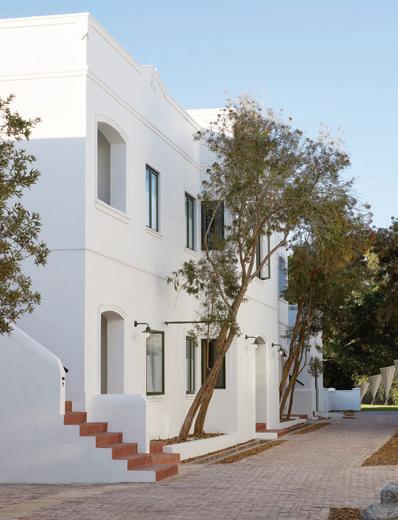
Having spent a decade shedding its reputation for tour buses and conference groups, the opening of the reimagined Spier Hotel marks the final step in Spier Wine Farm’s metamorphosis into a boutique destination. In many ways, it is the final piece of the puzzle; the keystone that holds it all together.
As I step into the luxury hotel’s new reception area – luggage whisked from my hand and swiftly replaced with a glass of Cap Classique – the transformation is immediately apparent. Here, elements of Cape country heritage shine through a modern lens: screed floors and whitewashed beams nod to the Cape Dutch aesthetic, while contemporary furnishings and artworks fill the space with colour and creativity. A vast mural by earth artist Hanien Conradie frames the reception desks, just one of over 1 000 pieces on display across the estate.
These public areas, along with the two renovated restaurants, are the work of Sophie Douglas and Lucy Watkins from the London-based studio Fusion Design, who worked closely with the family owners of Spier to organically weave the key elements of the estate into the look and feel of the space.
“The owners don’t like hotels – they like homes. So that idea of ‘home’ had to be central,” explains Sophie. “From the very beginning, they asked, ‘How do we tell our stories?’ That was the big brief: where and how does the storytelling come in? We didn’t want to rely on literal storytelling. No walls of text explaining who we are, it needed to be woven into the design –subtle and immediate. The moment you step in, you’re experiencing Spier: the art, the wine, the land.”

evolution Talkin’ about an
THE NEW SPIER HOTEL CELEBRATES CONNECTION THROUGH FOOD, WINE, HERITAGE, AND ART WORDS RICHARD HOLMES
Despite the bustle of the hotel, the lobby’s homely central hearth forms a natural gathering point in the crispness of a Cape winter. Off the lobby, a curated boutique – a microcosm of the larger Cowshed shop on the estate – is filled with bespoke local creations. Think amenities by O’live, Karoo knitwear by Blankets for Africa, raffia bags by AAKS in Ghana, and room diffusers by Saint VII. I make a mental note to return later with my credit card.
Across the property, the hotel feels familiar yet reinvented. While most redevelopments aim to expand, Spier Hotel has reduced the number of guest rooms from 155 to 80, reinforcing a new boutique approach to hospitality.
Although the original Georgian-style room blocks remain, brick pathways and landscaped gardens create a more village-like atmosphere in the space.
“The design isn’t static either. It will keep evolving. We’ll continue layering and developing the interiors in a personal, seasonal way. Spier is a family – it’s a spiritual anchor for the people who live and work there,” says Sophie.
“The owners don’t like hotels – they like homes. So that idea of ‘home’ had to be central”
Indoors, the rooms and suites have been reimagined thanks to the deft touch of Marguerite Louw Design, who has infused the spaces with contemporary interiors defined by organic tones, local textures, and handmade furnishings that pay homage to Cape heritage and the lush landscapes of the farm. The embroidered scatter cushions from Casamento are a particularly lovely touch, balanced neatly by refurbished and upcycled pieces from the original hotel.


“Being resourceful and pushing myself to think a bit harder not only reduced the carbon footprint of this project, but also freed up the budget to spend on crafting bespoke details that add originality, interest, and a certain quirkiness,” says Marguerite. “In my experience, constraint very often leads to better design. Overall, we were conscious of investing money where it had the greatest impact and the added joy of creating work for talented craftspeople.”
Marguerite was also the creative force behind the new spa, where the Cape floral kingdom takes centre stage, informing both the aesthetic and the wellness philosophy. From the apothecary-style emporium welcoming guests, the herbal teas served in the serene relaxation lounge, to the botanicals picked from Spier’s own fynbos gardens, there’s a deeply rooted sense of terroir in the wellness offering.
That is best discovered at the Cape Herbal Bath House, where guests surrender to a three-hour ‘bathing ritual’; a multi-sensory wellness experience that rolls from a hot-slab massage and salt scrub, to steam and hot-stone therapies infused with the healing oils and aromas of Cape botanicals. It’s all set in a charming vintage-style space featuring handcrafted tiles, bespoke marble basins, and antique brass window panels, a sense of heritage echoing throughout.
Spier has always been a pioneer of regenerative farming in the winelands, and that philosophy underpins the hotel’s new culinary offering. The Garden Room offers casual daytime dining with a menu that leans happily into the flavours of heritage Cape cuisine. Don’t miss out on the delicate umfino gnocchi in a rich caponata of smoked tomatoes.
A MULTI-GEN ESCAPE
The Spier Hotel welcomes families with new offerings like the Buzz Club, a screen-free, nature-based play zone for young travellers complete with mud kitchens and farm-focused activities. These are guided by trained child-minders.
Look out for the launch of Spier’s two new three-bedroom villas in spring. Both offer a more exclusive winelands retreat with a private chef and butler, your own pool, and outdoor living areas.

TOP: From the shared spaces to its more intimate rooms, Spier Hotel combines heritage with bespoke design
BELOW: Veld restaurant offers seasonal menus that honour South African flavours

Alongside, Veld delivers a more refined dining experience; an elegant space where an open kitchen and a cascade of greenery combine with saffron banquettes and intimate tables. The menu’s seasonal dishes are curated with produce from Spier’s extensive food gardens and pastures, and what can’t be grown on the farm is sourced from local suppliers who share a similar sustainability ethos.
Beyond its farm-to-table philosophy, the menu draws on global inspiration. Marinated tomatoes are lifted with za'atar, deconstructed mushrooms are given an Asian twist in pickled shimejis, and a roasted Kashmiri masala cauliflower steak packs a punch. For dessert, try the Cape Malay koe'sisters or the Kalahari Broffie, a seductive brandy tart with coffee crémeux, espresso ice cream, and brandy snap crumble.
Of course, wine remains at the heart of the Spier experience and the curated wine list offers both by-the-glass options and vintage gems. Hotel guests are invited to sensory tastings in the Wine Library or can head upstairs to the rooftop bar for sundowners served with panoramic views across the estate and Eerste River to the Stellenbosch mountains. It’s a fine setting to raise a glass to a family estate that has firmly found its sense of place in the Cape winelands. ■ spier.co.za
CUT Director’s
Angus Gibson is not just a director – he’s a seer of stories, a listener of silences, and a man who has spent four decades reflecting South Africa back to itself. He co-created the landmark television series Yizo Yizo unearthed the soul of Orlando East in Zone 14, and brought polygamous rural life to prime time in Isibaya. He’s also the visionary behind Shaka iLembe one of the most ambitious retellings of Zulu history.
His work has earned global recognition: an Oscar nomination for Mandela: Son of Africa, Father of a Nation and a Royal Television Society Award for 21 UP South Africa: Mandela’s Children In 2023, Angus received the GQ Lifetime Achievement Award, and in 2024, the Order of Ikhamanga in Silver from President Cyril Ramaphosa.
LEGENDARY SOUTH AFRICAN DIRECTOR AND PRODUCER ANGUS GIBSON HAS REDEFINED HOW SOUTH AFRICANS SEE THEMSELVES ON SCREEN, THROUGH STORIES THAT SPAN GRITTY TOWNSHIP LIFE TO THE MAJESTY OF ZULU ROYALTY
COMPILED BY PHILA
TYEKANA
WHAT WAS IT ABOUT THAT WORLD THAT PULLED YOU IN? The energy. The aesthetic. The music. The imperfections. It all felt alive in a way that white suburbia didn’t. I’m not trying to claim anything – I’m a white man with a white family I love. But something about black South African life gave me something to respond to, emotionally and creatively.

WHEN DID YOU REALISE FILMMAKING WAS IT? By accident. I was at Wits studying economics and pure maths, a terrible fit. One day, I went to see 2001: A Space Odyssey. It was sold out. So I walked next door and watched The Passenger by Michelangelo Antonioni. I came out of the cinema and said, “I’m going to make movies.”
WHAT DID YOUR PARENTS THINK? They were tolerant, but unsure. Even when Mandela got an Oscar nomination, I don’t think they believed it was a proper job. But they were loving. My dad was a gold miner turned farmer, my mum a devoted homemaker. I grew up in KwaZulu-Natal in safety and a ection. That’s given me the freedom to take risks.
WHEN DID YOU BECOME DRAWN TO BLACK SOUTH AFRICAN STORIES?
When I was 20, I climbed a mine dump near where FNB Stadium is today and saw Soweto for the first time. Endless. Alive. I’d never been to a township before. That moment hit me hard – how much of my country I’d never touched. I knew I had to go in. In the ’80s, I made documentaries in the townships. That led me into drama, and the stories followed.


TELL US ABOUT SHAKA ILEMBE SEASON 2… The world is now familiar to the audience. Shaka’s power is growing, his empire expanding, and the emotional intensity has deepened. We lose characters we’ve grown to love. There’s betrayal, love, and revenge. It’s grand, but it’s also human.

WHAT KIND OF BOSS DO YOU THINK YOU ARE? I’d like to think I listen. I’m not an auteur trying to push a solo vision. I’m a collaborator. I want to build things with people, not over them.
DO YOU HAVE A NICKNAME IN THE TOWNSHIP SPACE?
Bra Gibb. It stuck after the character and thug in Yizo Yizo. WHICH ACTOR OR PERFORMANCE SHOCKED YOU THE MOST?
Ronnie Nyakale and Ernest Msibi as Papa Action and Chester on Yizo Yizo. At first, people doubted the casting. But when they stepped into wardrobe, they became those characters. Melusi Mbele, who played Bhekumuzi in Isibaya, was another standout who had a rare spark. Andile Mxakaza, who started as a personal trainer, became a fan favourite as Fezile on Isibaya
TELL US ABOUT YOUR PRODUCTION COMPANY, THE BOMB SHELTER… We aim to do what hasn’t been done before. Yizo Yizo broke ground in how urban life was shown. Isibaya took us back to the ruralurban dynamic. Ayeye brought something fresh about adulthood.
HOW DO YOU WANT TO BE REMEMBERED?
As someone who reflected South Africa truthfully – and entertained in doing so. WHICH PROJECT IS CLOSEST TO YOUR HEART? Yizo Yizo Season 1. And Zone 14. We filmed inside the community in Orlando East. They embraced us. That kind of connection was a rare, beautiful bond between a community and a show. WHAT IS LUXURY TO YOU? Time is a luxury for me. Time to craft, time to think, time to explore. And downtime. ■
BELOW:


ABOVE, FROM TOP: With some of the cast and crew at the premier of Shaka iLembe; On the set of Shaka iLembe with Lemogang Tsipa; With Ronnie Nyakale (left) and Ernest Msibi (right) on the set of Yizo Yizo
With Nelson Mandela for Mandela: Son of Africa, Father of a Nation




